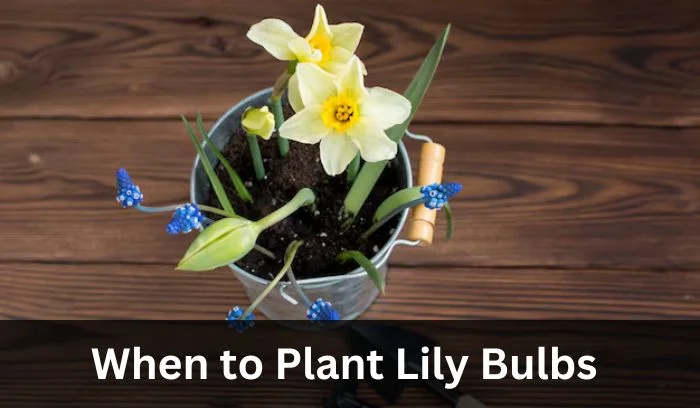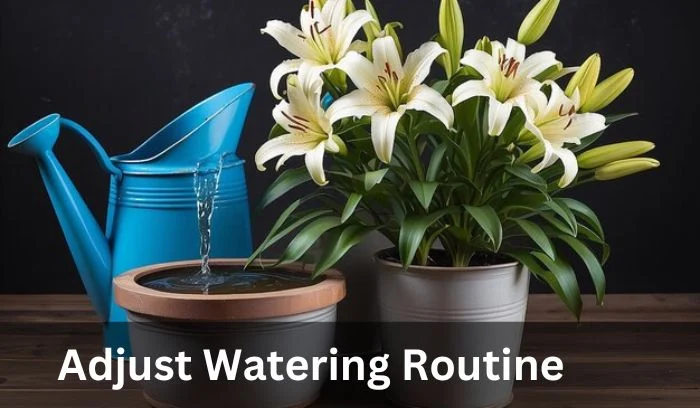When lilies seem to grow at a slow pace and break the ground much later than expected, don’t worry—this is a common issue. Several reasons could explain why your lilies aren’t sprouting as quickly as you’d like.
It could be the weather, with cold temperatures or inconsistent rainfall, or the soil that may not be suitable for the bulbs you’ve planted. These factors can delay the growth process, making your lilies take longer to appear above ground.
One of the most easy-to-understand things you can do is check how you’ve planted the bulbs in the first place. If they are too deep or not in the best spot, they might struggle to sprout. Slowing down their growth can also happen when the environment doesn’t meet their needs for warmth and moisture.
To help your lilies sprout faster, try adjusting the planting depth or moving them to a more favorable location. Once you know the right steps to take, you’ll see them walk their way to the surface in no time.
Key Insights On Lily Sprouting
| Aspect | Details |
|---|---|
| Reason for Slow Growth | Lilies take time to establish their roots through rhizomes before breaking ground. |
| Underground Process | Growth begins with the development of adventitious roots and eyes on the rhizomes. |
| Timing | Lilies may take weeks or months to sprout depending on soil conditions and type. |
| Factors Affecting Growth | Temperature, soil moisture, and depth of planting can influence how quickly lilies break ground. |
| Growth Habit | Once established, lilies spread and grow steadily via underground rhizomes. |
What Does a Lily Look Like?
A lily is truly breathtaking with its eye-popping colors. You can find them in a variety of shades like orange, pink, yellow, purple, red, and white, making them stand out in any garden.

These flowers are often trumpet-shaped, with six delicate tepals or petals that create a beautiful, star-like shape. The long, erect stems support the flower, while the narrow, lance-shaped leaves give it an elegant look.
What really makes the lily so stunning is how the colors seem to pop against the backdrop of its natural green leaves. Whether you’re looking at the bold orange or the soft pink, the combination of the vibrant petals and sleek stems creates a flower that’s impossible to miss. From its distinct shape to its wide range of colors, the lily is a flower that captures attention with its elegance and charm.
Why Are Lilies Slow to Break Ground? Common Reasons
There are a number of reasons why lilies may take a while to establish. Cold soil, improper planting depth, or poor soil quality may all slow their growth. If the weather is too cold or there’s not enough sunlight, the bulbs might struggle to sprout. Overwatering or pests damaging the bulbs can also delay growth.
These are common reasons that can affect how quickly your lilies sprout and grow.
Cold Weather and Soil Temperature
Lilies are particularly sensitive to cold weather, and this can significantly affect how slow they are to break the ground. If you’ve planted them in early spring or if the weather has been unusually cold, the soil may not be warm enough for the lilies to sprout.

Temperature plays a crucial role, as the ideal soil temperature for lilies to start growing is around 60°F (15°C). If the ground is still too chilly, the lilies stay dormant for a longer time, making it feel like they are taking forever to grow.
It can sometimes take weeks of warm weather to get the soil heated to the right temperature, which is essential for the lilies to break their dormancy and start growing. Without enough heat or the right warmth, the lilies won’t grow as quickly, so a little patience is needed in the meantime.
Planting Depth
If lilies are planted too deep, they may take forever to break through the ground. When bulbs are placed much deeper than the recommended depth, it can slow their growth and make it take longer for them to reach the surface.
In my experience, planting bulbs at a depth greater than 4 to 6 inches can really slow things down. Lilies are supposed to be planted at a depth where they can comfortably push through the soil without much resistance.
It’s always a good idea to double-check your planting depth before you start. By ensuring that you’re planting the bulbs at the right level, you give them the best chance for healthy and faster growth. A little extra attention to depth can make a big difference in how quickly they sprout.
Poor Soil Quality
The type of soil you use significantly impacts how quickly your lilies emerge from the ground. Lilies thrive in nutrient-rich, well-draining soil. If the soil is compacted or heavy with clay, it can hinder their growth and delay their progress.
The roots will have a harder time pushing through compact soil, and this can cause a delay in sprouting. In my garden, I noticed that when I used well-aerated, mixed soil with organic matter, my lilies grew much faster.
If the soil is too thick or dense, water can get trapped, leading to over-watering problems, which can also affect how well your lilies spread and emerge. So, it’s important to ensure the soil is light and well-draining for the best results.
Lack of Sunlight
Lilies are sun lovers and need a good amount of sunlight to grow strong and fast. If they don’t get enough light, it can delay their sprouting and affect their growth. Researchers have found that sunlight plays a big role in promoting plant growth, especially for lilies.
For them to flourish, they usually require at least six hours of sunlight per day. Without it, the bulbs don’t get the warmth they need, and that slows down the entire process.
In my own experience, planting lilies in a shady spot caused them to take much longer to grow. They weren’t receiving the energy from the sun that they needed to push through the soil. To avoid this, make sure you plant your lilies in an area with plenty of sun. If they are in a spot that gets the right amount of light, they will grow faster and healthier.
Overwatering or Underwatering
Watering plays a big role in how your lilies grow. If you overwater them, the bulbs can become waterlogged, which can slow down their growth or even stop it completely.
The soil needs to stay moist, but not soaking wet, because too much water can cause the bulbs to rot. This is often a big reason why some lilies never break ground.
On the other hand, if you underwater your lilies, the soil will become too dry and the bulbs won’t have enough moisture to sprout and grow properly. Finding the right balance in watering is key to ensuring your lilies thrive.
Pests and Diseases
Sometimes, pests and diseases can be the reason your lilies are slow to break ground. Insects like bulb mites or other underground pests can attack the lily bulbs, causing damage before they even start to grow.
These pests feed on the bulbs, making it harder for the lilies to sprout. I’ve experienced this in my own garden, where a few bulb mites delayed the lilies’ growth for weeks. Checking your bulbs regularly for any signs of pests is crucial.
Additionally, according to PennState Extension, diseases like bulb rot or fungal infections can also stop the bulbs from growing. Treating these issues early on can prevent long-term harm. If you notice any problems, be sure to act fast to protect your plants and help them thrive.
When to Plant Lily Bulbs
For the best results, you should plant lilies during the fall, ideally at least four weeks before the first fall date in your region. This timing allows the bulbs to adjust to the winter season’s chill, which helps produce large blooms by spring. If you’re in an area with harsh winters, consider planting your lily bulbs in spring instead, when the weather is more favorable for growth.

It’s essential to purchase your lily bulbs close to the desired planting time since they may deteriorate if stored for long periods. Planting at the right time in your region ensures that your lilies grow strong and produce beautiful blooms as soon as the weather warms up.
Where to Plant Lilies
Lilies thrive when they get 6-8 hours of direct sunlight each day, so it’s important to choose a spot that gets full sun or partial shade. For the best results, try planting them where they get morning sun and some afternoon shade, or in a spot with dappled sun throughout the day. If they don’t get enough sunlight, the stems will become spindly and the plants might fall over.
Next, lilies prefer well-drained soils. Avoid areas where the soil can become waterlogged, as this can damage the bulbs. Lilies are flexible and can grow in a variety of soil types such as clay or sand, but they do best in neutral to slightly acidic soil. They can tolerate a wide range of pH levels, but too much acidity or alkalinity might affect their growth.
Preparing the Site/Working the Soil
When it comes to planting lilies, they thrive when undisturbed for years, making it important to take the time to prepare the soil properly. Start by using a spade or rototill to break up the ground to a depth of about 12-15″. This ensures the soil is loose enough for roots to grow and spread freely.
Once the area is dug up, it’s essential to amend the soil by adding a generous 2-4″ layer of materials like dehydrated manure and garden compost. If the ground is already rich with garden loam and well-drained, adding Breck’s Food foBulbs and perennials thrive best when grown under optimal conditions, ensuring excellent growth and vibrant blooms, as suggested by Breck’s Dutch bulb specialists.
For those with clay soil, adding rock dust or crushed stone can improve drainage, a crucial step to avoid waterlogging. On the other hand, if you have sandy soil, mixing in a bit of clay will help with nutrient retention and moisture control, allowing the soil to better retain vital nutrients. Whether you’re planting perennializing flowers or other plants, making sure the soil is amended properly ensures that the plants will thrive for years to come.
How to Plant Lily Bulbs
To start planting lily bulbs, first ensure the soil is loosened and improved. Dig a hole approximately 6-9 inches deep and position the bulb at the bottom, ensuring the roots are pointing downward. To get rid of air pockets, cover the bulb with earth after it is in position and gently press down.

Afterward, water thoroughly to help the bulb settle into its new home. The recommended spacing for each variety of lily is typically mentioned on the bags in which the bulbs are shipped, so be sure to follow those guidelines for healthy growth.
In regions with warmer summers, you may want to plant the bulbs a bit deeper to keep them cool as temperatures soar. In cooler climates, you can plant them shallower to allow the developing stem to send out roots more easily. Deep planting helps stabilize the plant and supports the bulb in sending out strong roots, ensuring a stable, flourishing plant in the future.
Mulching and Winter Protection
To protect your lilies during winter, apply a year-round mulch made from materials like compost, leaf mold, or leaves. These organic mulches have a positive effect on the soil by preventing it from drying out and maintaining a more even, cooler temperature.
This is especially important during fluctuating weather, where freezing and thawing can stress the plants. Adding a 2-4 inch layer of mulch improves soil structure and supplies organic matter that enriches and supports plant growth.
Not only does this mulch reduce weed growth, but it also helps prevent the bulbs from being heaved out of the ground due to the alternate freezing and thawing cycles. In addition, it stabilizes the soil, ensuring that the bulbs stay safe and protected from harsh weather conditions.
Lilies Slow to Break Ground? Try These Fixes
Warm the Soil
If the cold weather is holding back your lilies, there’s a simple way to speed up their growth: warming the soil. One method that works well is using mulch or plastic sheeting to cover the planting area. This traps heat, which helps the soil warm up much faster.
I tried this method in my garden, and I noticed that my lilies broke ground quicker than before. The mini greenhouse effect created by the mulch or plastic really helped keep the temperatures consistent, providing the warmth the lilies need.
Another effective way to get your lilies growing faster is by planting them in raised beds. The soil in raised beds tends to warm up much faster than the ground-level soil, giving your lilies a head start.
This method is great for areas with chilly temperatures, as it allows the soil to retain heat and encourage healthy growth. Just be sure to monitor the temperatures and keep them consistent, as lilies thrive best in stable, warm conditions.
Adjust Planting Depth
If your lilies are planted too deep, they may not sprout properly. To give them the best chance of growing faster, you might need to gently replant them closer to the surface. For best results, plant the bulbs 4 to 6 inches deep in the soil. This helps the bulbs get the right conditions to sprout more quickly.
When replanting, handle the bulbs gently to prevent any damage.Make sure the soil is loose and easy to dig through so you don’t hurt the roots. After replanting, I’ve found that the lilies tend to sprout quicker, giving them a better chance of healthy growth.
Improve Soil Quality
If your lilies are slow-growing, one way to speed them up is by improving the soil quality. When the soil is dense or full of clay, it can slow down growth. To fix this, you can amend the soil by adding organic matter like compost or peat moss.
This will make the soil looser, ensuring it is well-drained, which is just what lilies need. With better drainage, the roots can spread easily, helping the plants grow faster and become healthier.
I’ve found that adding compost not only provides the necessary nutrients but also keeps the soil light enough for roots to grow freely. If the soil is still too heavy, adding some sand can improve drainage, creating a better environment for your lilies to thrive. This huge difference in the soil texture will help your lilies flourish.
Provide More Sunlight
If your lilies aren’t getting enough sunlight, it could be slowing their growth. Moving them to a sunnier spot in your garden can make a huge difference. Lilies need at least 6-7 hours of direct sunlight every day to grow properly. If they’re in a shady corner, try relocating them to a brighter spot where they can get plenty of sun.
After moving mine, I noticed my lilies started growing faster, and I didn’t have to wait long for them to sprout. If your lilies are already in the ground, it might take until next season, but the results will be worth it.
Sometimes, it’s not just about moving plants. Even trimming nearby plants that are casting shade can help improve sunlight exposure. Making this small change can bring a big difference in how your lilies perform.
Adjust Watering Routine
You must modify your watering schedule to encourage your lilies to germinate and grow more quickly. If you’ve been overwatering, it’s time to let the soil dry out a bit between waterings.

Lilies don’t like to sit in soggy or wet soil, so it’s important to keep it moist, but not too wet. On the other hand, if you’ve been underwatering, start giving them a little more water regularly. Achieving the right balance is essential for healthy growth.
I use a moisture meter to check the soil before watering, which helps me avoid overwatering or underwatering. It’s a simple tool, but it ensures that my plants stay in the perfect environment. With consistency, I can keep the soil evenly moist and speed up their growth. By getting the watering just right, your lilies will grow stronger and healthier.
Protect Against Pests and Diseases
To keep your lilies healthy and growing stronger, it’s important to check the bulbs regularly for any signs of pests or diseases. One common problem that can harm your plants is bulb mites, which can damage the bulbs and prevent them from sprouting properly.
I’ve personally dealt with this issue before, and I found that using neem seed oil was an effective way to get rid of the mites without harming the plant. This approach serves as an effective natural method for pest control. If you notice soft spots or discoloration on the bulbs, it’s a good idea to treat them early to avoid further damage. Early intervention helps bulbs grow faster and stay healthy.
Another way to protect your garden is by introducing beneficial insects, like ladybugs, which are natural predators of harmful pests. These little creatures can help keep the pest population under control without the need for chemical treatments.
In my experience, a combination of control methods, such as using neem oil and encouraging ladybugs, creates a stronger defense against harmful pests. By taking proactive steps and treating any problems early, you’ll give your lilies the best chance to grow stronger and healthier, ensuring they thrive year after year.
How to Care for Lilies
When it comes to caring for lilies, one of the first things to consider is their preference for rich soil. A well-balanced, nutrient-dense environment is essential for these beautiful blooms. For the best results, applying Breck’s Food for Bulbs and Perennials in early spring is a great idea.

This helps support the growth of lily sprouts as they emerge. Repeating the surface application once the flowers open in summer ensures continuous nourishment. Keep in mind that lilies in areas with high rainfall or planted in sandy soil may need more frequent feeding than those grown in clay soil.
In regions where natural rainfall falls short of about 1 inch per week, it’s crucial to provide additional watering. Once the flowers have bloomed, it’s time to remove the spent flowers to avoid the formation of seed pods, which can drain energy from the bulb.
Lilies in Containers
When growing lilies in containers, it’s important to choose larger containers, ideally at least 10 gallons. The roots will have plenty of room to grow in a container that is at least 12 inches deep. Taller types of lilies may need extra support to stay upright.
For an ideal growing environment, choose a commercial potting mix with added porosity. In clay pots, place a layer of drainage materials like rocks or small stones at the bottom before adding the potting mix.
It’s also recommended to plant the bulbs closer together than in the garden, placing them about 2″ between bulbs to create a full, attractive display.
In colder months, lilies in containers should remain outside to experience the cold season, but in regions with severe frost, move the pots indoors to a cool place. To prevent water buildup and lily rot, make sure the containers have drainage holes.
Without proper drainage, the pots may freeze and fill with ice, which can harm the bulbs. In fall, once the foliage dies down, it’s time to re-pot or transfer the bulbs to the garden. If you decide to keep them in the same pot for a second season, make sure to replace the top 2″ of compost with fresh compost, adding fertilizer or well-rotted manure for extra nutrients.
Lilies as Cut Flowers
Lilies make excellent cut flowers, especially when you pick them just as the buds are beginning to open. If you wait until the flowers are fully open, you may want to remove the orange pollen-coated stamens to avoid staining your clothes or furniture.
Some double flowering lilies and newer cultivars don’t have pollen, so you won’t need to worry about this. When cutting lilies, always leave part of the stem to allow the plant to gather strength for the next year.
Once placed in a vase, make sure there are no leaves in the water, as they can spoil it. Since they aid in supplying nourishment to the unopened flower buds, the upper leaves of the stem should be left on.
To keep the flowers longer, place the vase out of direct sunlight and change the water regularly, ideally each day. Adding a drop of bleach to the water helps keep it clean. Depending on the variety, your blooms should last anywhere from 7-14 days.
Do Lilies Spread Underground?
When it comes to lilies, many gardeners wonder if these beautiful plants can spread on their own. The answer is yes, lilies spread underground through a special system of rhizomes. These rhizomes are essentially underground stems that have the unique ability to produce adventitious roots.
Each rhizome has eyes, which are growing points that trigger the growth of new plants. Over time, these growing points create additional underground growth, allowing lilies to multiply and spread across the garden.
As the rhizomes grow, they extend further into the soil and produce new shoots, leading to more lilies. This method of spread is incredibly efficient because each rhizome contains everything needed to create new plants. The process happens naturally, and as long as the conditions are right, lilies will continue to spread via their rhizomes, ensuring their presence in the garden year after year.
From my personal experience, once you have lilies planted in your garden, you’ll notice new lilies popping up in areas you may not have expected. It’s a wonderful, low-maintenance way for these plants to thrive and grow.
Types of Lilies
Asiatic Lilies
Asiatic lilies are the shortest type of lily, typically growing between two feet and three feet tall. They are known for their vibrant bright colors, which range from soft pastels to bold tropical colors, making them a beautiful addition to any garden. These lilies tend to bloom during the early summer, adding a burst of color when the season begins to warm.

One of the best things about Asiatic lilies is that they are easy to care for. As long as they are planted in well-drained soil and kept well-maintained, they will thrive. Although they are not known for a strong fragrance, their stunning appearance more than makes up for it. Whether you have a small garden or a large flower bed, these lilies are sure to brighten up your outdoor space effortlessly.
Trumpet Lilies
Trumpet lilies are known for their strong fragrances and abundance of blooms. While their flowers are generally smaller and tend to stay closed, they make up for it with their rich scent and beauty.
These lilies are easy to grow, making them a favorite for many gardeners, especially those looking for a low-maintenance plant. Typically, late bloomers, and trumpet lilies add a splash of color and fragrance to your garden well into the season, providing a long flowering season that keeps your space vibrant for weeks.
Even though their flowers are not as large as some other lily varieties, they still offer a striking visual appeal. Because they are easy to grow and thrive in many conditions, they make a perfect choice for both beginner and experienced gardeners alike. These lilies not only brighten up your garden, but they also fill the air with their delightful scent, making them a fantastic addition to any outdoor space.
Oriental Lilies
Oriental lilies are known for their strong fragrances that fill the air, offering a beautiful and sweet fragrance that can be enjoyed both indoors and outdoors. Similar to trumpet lilies, they produce large blooms that add elegance to any garden.
However, they tend to grow slower compared to other varieties, requiring patience before they reach their full beauty. These lilies can grow quite tall, often reaching heights of about four feet, making them a stunning addition to your garden. While they may take a bit longer to mature, the vibrant colors and rich scents they bring are absolutely worth the wait.
Tiger lilies
Tiger lilies are a stunning herbaceous perennial plant, known for their tall height of 3 to 5 feet. With striking orange petals covered in dark speckled spots, these flowers bloom beautifully in the summer.
Their strappy leaves add to their charm, and they grow best in full sun with slightly acidic, well-draining soil. Tiger lilies are adaptable to various conditions, thriving in hardiness zones 3 to 9 (according to the USDA), and can tolerate changes in temperature and humidity without much trouble.
These lilies are part of the Liliaceae family and are scientifically known as Lilium lancifolium or Lilium tigrinum. Their flowers come in a variety of colors, including red, yellow, white, and pink, making them a perfect addition to any garden.
The plant’s moist and loamy soil preference makes it easy to grow, and it’s important to note that they have toxicity, especially to humans and cats. Whether you’re gardening in Asia or elsewhere, tiger lilies can make a stunning impact in your garden with minimal care.
FAQs
Easter lilies planted in the ground in spring can survive for years with proper care. To help them thrive, mulch them heavily in the fall, especially in northern regions where winters are colder. With this care, they’ll likely bloom again in late summer.
From my experience, Easter lilies do well when planted in a sunny spot with good drainage. As long as you protect them with mulch, they’ll come back each year, brightening your garden season after season.
Lilies can gradually increase in numbers through naturalize by producing small bulbs along the old, below-ground stem. These new bulbs help the plant spread. Species lilies and tiger lilies tend to spread more than Hybrid or Oriental lilies, forming larger clumps in the garden bed.
In my experience, lilies will naturally fill the bed over time, creating a beautiful display as they grow and multiply from their main bulbs.
The average life of a lily bloom is 7-14 days, typically in the spring or summer. Known for their symbolism of celebration, ambition, and enthusiasm, lilies have a native origin that spans worldwide. From my experience, while their blooms are short-lived, they bring beauty and meaning to any garden or space.
Lilies from the lily family are dangerously toxic to people and pets. Many plants called lilies aren’t true lilies, but they can still be poisonous. For example, crinum lilies are also toxic despite their name. Always be cautious as these plants can cause serious harm.
Conclusion
Lilies can be slow to sprout due to factors like cold weather, soil conditions, and the environment. They take time to establish roots through rhizomes, with growth beginning at the adventitious roots and eyes. The timing of sprouting depends on soil type, temperature, moisture, and planting depth.
For healthy growth, plant lilies in good-quality soil at the right depth and ensure they receive plenty of sunlight. Overwatering, underwatering, or pests like bulb mites can also hinder growth. By adjusting planting conditions and addressing these issues, you can help your lilies sprout and grow faster.
See Also:
How to Grow Plants Along a Vinyl Fence: Step-by-Step Guide
When to Seed Lemongrass in Zone 9a? A Complete Guide
How To Plant, Grow, & Care For Hazelnut Tree (Complete Guide)
What Do Carrots Look Like When They Start to Grow
38 Types of Palm Trees That Grow Well in Florida (With Picture)



